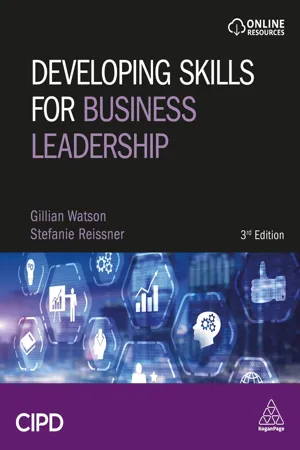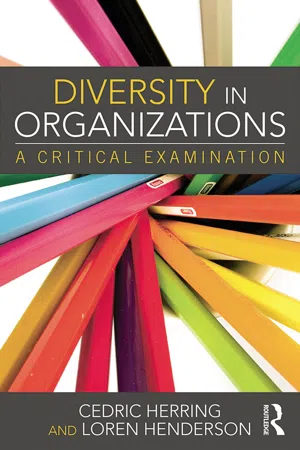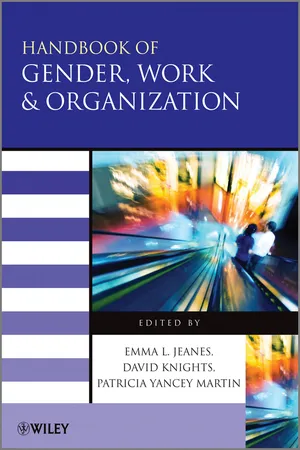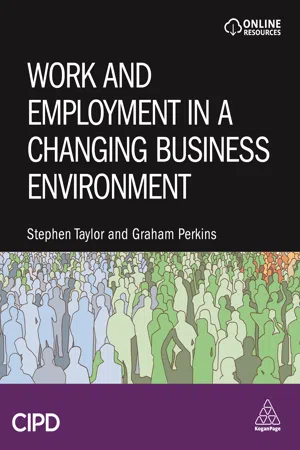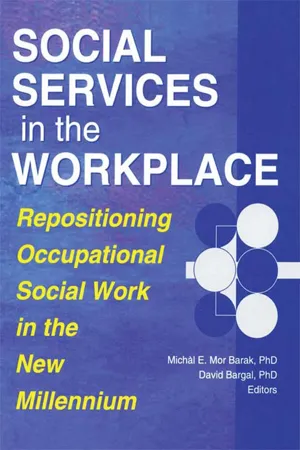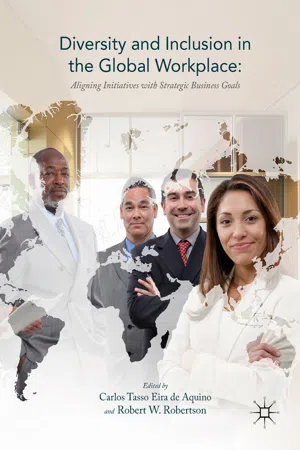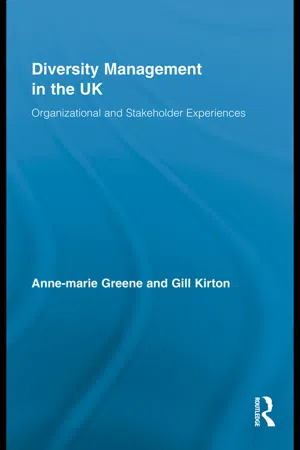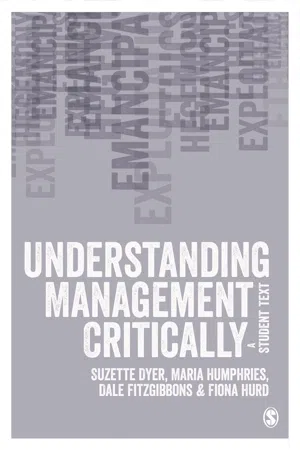Business
Diversity in the Workplace
Diversity in the workplace refers to the variety of differences among people in an organization, including but not limited to race, gender, age, ethnicity, sexual orientation, and physical abilities. Embracing diversity in the workplace can lead to a more inclusive and innovative environment, as it brings together a wide range of perspectives and experiences.
Written by Perlego with AI-assistance
Related key terms
Related key terms
1 of 4
Related key terms
1 of 3
11 Key excerpts on "Diversity in the Workplace"
- eBook - ePub
Developing Skills for Business Leadership
Building Personal Effectiveness and Business Acumen
- Gillian Watson, Stefanie Reissner(Authors)
- 2023(Publication Date)
- CIPD - Kogan Page(Publisher)
10Diversity in and around organisations
Introduction
The last few decades have seen a rise in diversity in societies and organisations around the world as people have become more globally mobile, people from traditionally under-represented groups are joining the labour force, and organisations are building global talent pools. Yet, at the same time, debates about gender equality and discrimination on grounds of ethnicity, sexual orientation or disability abound, despite comprehensive legislation in many countries that seeks to ensure equal opportunities for all. Although there has been some progress towards diversification of company boards, figures on the gender and race pay gaps continue to make for somewhat depressing reading. At societal level, the recent, well-publicised #MeToo and Black Lives Matter campaigns have highlighted just how much more must be done to achieve true equality in many, if not most, societies worldwide.The concept of diversity celebrates difference by recognising and respecting people’s personal characteristics. At the workplace, it is about valuing the contribution of individuals from various cultures, backgrounds and with a wide range of differing skills, abilities, experiences and mindsets. Diversity is increasingly used in the acronym EDIR – equality, diversity, inclusion and respect. Equality is about ensuring that people are not treated less advantageously because of their personal characteristics, such as ethnicity, gender, age, sexual orientation, religion, disability, etc. At the workplace, this means that everyone gets the same opportunity when it comes to employment, pay and benefits, promotion, etc. Inclusion refers to an environment that supports, welcomes and values people and their unique contribution, making them feel included in all opportunities the organisation provides. Respect is about paying attention to people, appreciating their opinions and valuing them for who they are. - eBook - ePub
Working with Children, Young People and Families
A course book for Foundation Degrees
- Billie Oliver, Bob Pitt, Billie Oliver, Bob Pitt(Authors)
- 2011(Publication Date)
- Learning Matters(Publisher)
A number of activities are introduced to enable the reader to critically reflect on their experience in practice settings. The chapter begins with an introduction to diversity and equality including an exploration of the legal and policy contexts that impact on services for children and young people. The activities in the first section are designed to assist practitioners to take a critical look at their own perceptions, knowledge and understanding of issues relating to diversity and equality. The activities in the second section, based on a practice scenario, are designed to enable the reader to begin to explore possible strategies towards developing and sustaining an inclusive working environment. In the final section, the activities engage the reader to take a more reflective and critical look at their own work environment in terms of the extent to which it is driven by inclusive practices, and identify potential solutions to some of the challenges encountered.Defining and understanding concepts and terminology
Diversity
Diversity is a contested concept. It is one of those terms about which we all have an opinion and yet it continues to challenge us in terms of having a shared understanding. The Collins Paperback English Dictionary (2000) defines diversity as the quality of being different and varied; a point of difference . This definition is useful to start our thinking about diversity. However, diversity, as far as our practice is concerned, is a complex issue and requires a more informed exploration of the concept. The Department of Health (DH) defines diversity as:This definition is important to practitioners as it acknowledges the link between diversity and equality.the recognition and valuing of difference in its broadest sense. It is about creating a working culture and practices that recognise, respect, value and harness difference for the benefit of the organisation and the individual. Equality and diversity are not inter-changeable but are inter-dependent. There is no equality of opportunity if difference is not recognised and valued.(DH, 2003, page 8 )Pincus (2006) provides a useful overview of diversity as conceptualised within the social sciences and this is summarised below:Counting diversity
One can conceptualise diversity purely in terms of such characteristics as age, race, gender, ethnicity and religion. As an example, this could entail counting the number of individuals in each of the above categories within a particular group or community and making comparison on how these are distributed within the wider society.Culture diversity
Diversity can also be viewed in terms of cultural differences within society and between groups. Greater appreciation of different cultures can be seen as contributing to greater accommodation and tolerance of differences. - eBook - ePub
- Lazenby JAA(Author)
- 2020(Publication Date)
- Van Schaik Publishers(Publisher)
199 One example of the complexity is a university in South Africa that allows people not to classify themselves according to the classical reporting categories. Being accommodative in the workplace towards, among others, the gay and lesbian society, is becoming increasingly important. In terms of Section 6 of the Employment Equity Act, discrimination based on gender and sexual orientation is specifically prohibited. With specific reference to gender, managers therefore need to be careful in all aspects of people management in the workplace.Despite the higher numbers of women in senior positions in organisations, a significant under-representation of women is still evident (see Management in action 9.4 ).MANAGEMENT IN ACTION 9.4
Workplace diversityWorkplace diversity emphasises gender representivity. Twenty-four plus years into democracy the representivity of women at senior management levels is still lower than the population representivity. Grant Thornton’s Women in Business Report 2019 indicates that internationally the percentage increased from 24% in 2018 to 29% in 2019. This makes it the first time the proportion of women in senior leadership has exceeded one in four. The report identifies, among others, the following three barriers for women in the workplace:- Lack of access to developmental work opportunities
- Restricted networking opportunities
- Caring responsibilities outside work
Source: Adapted from https://www.peoplemattersglobal.com/article/empower-her/2019-sees-the-highest-percentage-of-women-in-senior-management-globally-report-21036 (accessed on 28 August 2019)9.4.3 Ethnicity
Ethnicity is fundamental to Diversity in the Workplace, and is the one dimension of diversity that is most commonly experienced. Every day, as part of the interaction between employees, the “language barrier” and differences in culture are evident during the execution of work. The South African Constitution acknowledges 11 different official languages in the country and that official languages in the different provinces can be different. The debate about language in parliament, after the 2019 elections and the requirement for Constitutional determination, again emphasises language as an important aspect of diversity. All inhabitants of South Africa should also be sensitised to languages that are not recognised as official, such as Asian languages. - eBook - ePub
Diversity in Organizations
A Critical Examination
- Cedric Herring, Loren Henderson(Authors)
- 2014(Publication Date)
- Routledge(Publisher)
4Achieving Workplace DiversityAs the population of the United States continues to become more diverse, employers have come to realize that their success may be tied to the diversity of their workforce and practices.1 In particular, the recruitment, promotion, and retention of employees of color are increasingly important to success in business organizations.2 Although there are several moral and social arguments for recruiting diverse employees, the most compelling reasons to pursue a diverse workforce for many employers is that excellence in diversity recruiting relates to more customers, better service, and better performance. There is a global battle for talent, and any company that restricts its search for talent in any way—by race, gender, national origin, sexual orientation, or any other factor—gives its competitors who do not restrict their talent searches in such ways the clear edge that they can use as a competitive advantage. Such arguments resonate with employers of all sizes and industries. And recent research on the link between diversity and the bottom line has provided evidence supporting such thinking.3Proponents of diversity suggest that in the corporate setting, diversity represents a compelling interest that will help meet customers’ needs, enrich understanding of the pulse of the marketplace, and improve the quality of products and services offered.4 With respect to employees, diversity brings with it different perspectives. Because of the clear competitive advantages of diversity, employers increasingly have relied on a diverse workforce to improve their performance. Because diversity provides fresh ideas, strong growth, positive company images, fewer discrimination lawsuits, and an enhanced ability to hire qualified workers, employers should be aggressive about workforce diversity.5Diversity is not just about hiring minorities. It also involves cultivating and retaining talent from as broad a talent pool as possible. Successful organizations place emphasis on getting talented people and then providing the working conditions and best practices that will allow them to flourish within supportive environments. Although there are several case studies that document best practices that have worked within particular firms,6 - eBook - ePub
- Emma Jeanes, David Knights, Patricia Yancey Martin, Emma Jeanes, David Knights, Patricia Yancey Martin(Authors)
- 2012(Publication Date)
- Wiley-Blackwell(Publisher)
diversity in varying ways and some fail to define it at all. What is diversity? What makes any organization diverse? Kalev, Dobbins, and Kelly (2006) suggest that diversity is the presumed solution to ‘gender and racial segregation’ in organizations (p. 590), implying that segregation indicates a lack of diversity (segregation implicitly means that women and racial/ethnic minorities are excluded from senior management jobs and/or are crowded into lower status or lower skilled jobs). Bassett-Jones (2005: 169–170), in contrast, offers a broader definition; diversity is ‘. . . a range of differences in ethnicity/nationality, gender, function, ability, language, religion, lifestyle or tenure.’ Diversity means more than ‘demography,’ he says; it takes into account cultural and intellectual capacity differences. Bassett-Jones emphasizes the latter point to assert that more than demographic variation is required for diversity to help companies perform better. The varying views of diversity in organizations and management are suggested by data in Table 1, showing the frequency with which particular phrases have been used in social science literature (based on the Thompson Web of Science ISI system that indexes refereed articles in a database containing thousands of journals from around the world). The top of Table 1 shows that cultural diversity followed by ethnic and national diversity have been studied most, with gender diversity close behind (for more on ethnic diversity, see Calás and Smircich, this volume). To see if the wording affects the results, the phrases ‘gender diversity’ and ‘diversity and gender’ were inserted to provide comparisons - Stephen Taylor, Graham Perkins(Authors)
- 2021(Publication Date)
- CIPD - Kogan Page(Publisher)
Important within this definition is the central idea within equality theory that no one should be treated differently on the basis of a specific protected characteristic. In the UK, the Equality Act 2010 enshrines the protections afforded to individuals, meaning that it is unlawful to discriminate on the basis of age, disability, gender reassignment, marriage/civil partnership, pregnancy and maternity, race, religion/belief and gender. Interestingly, the definition makes specific reference to the idea that ‘no one should have poorer life chances’ (EHRC, 2019) as a result of their circumstances, and this is an important foundational concept within the area of equality. The EHRC argues that since the UK introduced anti-discrimination legislation in the 1970s, we have made progress towards being a more equal society. They suggest that outdated attitudes and stereotypes, for example the ‘stay-at-home mum’, have begun to fade. But, having said that, statistical data from organisations such as the Office for National Statistics and reporting from organisations regarding gender pay gaps (CIPD, 2019) still show that females typically earn less than males, and that the lack of female representation in high-paid, board-level positions is still an issue (Terjesen and Sealy, 2016). The presence of such issues suggests that, whilst progress has been made, it would be demonstrably fallacious to argue that further steps cannot be taken to promote equality and diversity within our organisations. It has been argued that discriminatory stereotypes and attitudes persist because of a number of deep-seated psychological mechanisms, and although an exploration of these is beyond the scope of the current book, this is an area of active scholarly and practitioner research interest.Moving on from the subject of equality, we come to diversity. Many scholars and writers within this field conflate the terms ‘diversity’ and ‘inclusion’, which again adds a level of confusion to the territory. For our purposes, the CIPD (2018) suggests a straightforward definition:Diversity is about recognising difference, but not actively leveraging it to drive organisational success. It’s acknowledging the benefit of having a range of perspectives in decision-making and the workforce being representative of the organisation’s customers.Perhaps the key point of note within this definition is the idea that diversity is about the recognition of difference, but that this does not automatically extend to our organisations actively taking advantage of difference to drive improved performance. This presents somewhat of a problem with current approaches to diversity management, but helpfully a resolution is found when we consider the subject of ‘inclusion’:Inclusion is where difference is seen as a benefit, and where perspectives and differences are shared, leading to better decisions. An inclusive working environment is one in which everyone feels valued, that their contribution matters and they are able to perform to their full potential, no matter their background, identity or circumstances. An inclusive workplace enables a diverse range of people to work together effectively.- eBook - ePub
Strategic Human Resource Management
An International Perspective
- Gary Rees, Paul Smith, Gary Rees, Paul Smith(Authors)
- 2021(Publication Date)
- SAGE Publications Ltd(Publisher)
9 Equality and Diversity in the WorkplaceJohn NeugebauerI don't want to be unkind, but really think about what you are asking me, and why you are asking it. Because you want me to play some game of stereotyping, and I don't want to. (Clare Balding on being questioned about her sexuality, in Cochrane, 2013: 29)Chapter Overview
This chapter will consider equality, diversity and discrimination in the workplace. The workplace has become a highly regulated environment in which many forms of discrimination are unlawful. Legal compliance is important, but there is ample evidence that seeking to avoid discrimination by legal means alone fails to understand the root causes and effects of workplace discrimination; fails to consider underlying workplace cultures; fails to consider the potential benefits of greater equality and diversity; and fails to recognize how the excessive imposition of legal remedies may even be counter-productive. Therefore, this chapter will critically examine the wider background to the causes and effects of discrimination and how and why organizations attempt to address these. The focal point is Europe and the UK, and reference is also made to global diversity issues.Inequalities within the workplace often reflect inequalities brought in from wider society. After a brief review of global inequality and discrimination, the chapter will consider how stereotype often forms the basis for subsequent discrimination. It will then review the impacts of inequalities on various minority groups within the workplace. This review of minority group impacts will consider gender and age inequality in depth. This is not to suggest that other forms of discrimination are any less important, but this will illustrate the range of complexity in understanding and addressing contemporary equality and diversity issues. - eBook - ePub
Social Services in the Workplace
Repositioning Occupational Social Work in the New Millennium
- David Bargal, Michal E. Mor Barak(Authors)
- 2013(Publication Date)
- Routledge(Publisher)
The conceptual model presented in this article is in line with social work's emphasis on improving the person-environment fit. It, therefore, implies that in order to initiate change in the organization it is not enough to introduce diversity training programs; in the best case scenario these programs bring about change that is limited to individuals’ behavior. The model implies that concurrent with such programs the organization needs to examine critically and change its policies and the way they are carried out in the organization. The purpose of such examination is to ensure fair and inclusionary treatment of women, members of racial and ethnic minority groups and other individuals who are different from the organization's mainstream. A strong message in support of inclusion with respect to diversity needs to come from top management. For example, Procter & Gamble chairman John Pepper's initial message to his employees was that of a strong commitment to diversity in the company through promoting the individual careers of members of the company's diverse workforce (Labich, 1996).The most important practice implication derived from this article's model is that it is important for management to push beyond affirmative action programs and to create a work environment that is inclusive and that values the diversity of its workforce. This can be done through deliberate actions such as:• A strong mentoring process that will bring employees who are different from the organization's main stream into the inner circles of the organization and will help them design successful careers. • Focus groups with new employees and with members of diverse groups to hear their needs and complaints directly and to initiate policy changes to accommodate such needs. • Workshops that raise awareness of exclusion and teach behaviors that are respectful and inclusive of diversity.Valuing and managing diversity means creating an organizational environment where every employee can reach his or her full potential (Cox, 1991). Efforts to value diversity can go beyond establishing legalistic definitions of “protected classes” to recognizing both observable differences, e.g., gender, age, race, ethnicity, and unobserv-able ones such as religion and sexual orientation (Fitzsimmons & Eyring, 1993). The organizational inclusion model presented here can serve as a tool for organizations to move beyond the current descriptive analyses of workforce diversity demographics and to create organizational change that will promote a more inclusive work environment. This model can begin an important effort to place diversity within a dynamic organizational context, and to provide a critical link between diversity and organizational effectiveness, making diversity an integral part of organizational strategy and operations. - eBook - ePub
Diversity and Inclusion in the Global Workplace
Aligning Initiatives with Strategic Business Goals
- Carlos Tasso Eira de Aquino, Robert W. Robertson, Carlos Tasso Eira de Aquino, Robert W. Robertson(Authors)
- 2017(Publication Date)
- Palgrave Macmillan(Publisher)
It is also crucial to advancing equal access and opportunity for members of minority populations in the workplace through inclusionary practices. Globalization and distributed workforces around the world have changed the makeup of the workforce domestically and internationally. International demographic trends indicate that in many developed nations, an aging population coupled with a low birthrate forebodes workforce shortages that will be impossible to fill without hiring migrants and immigrants, thus further diversifying the workforce. The concept of racial and ethnic diversity in the United States has expanded from an initial focus on racial, ethnic, and linguistic minority groups based on US Census categories, such as Black/African American, Asian, indigenous peoples (American Indian/Alaskan Native, Hawaiian Native/Pacific Islanders), and native Spanish speakers —to include peoples from the Middle East and North Africa (MENA) regions and practicing Muslims. Open borders and migration in the European Union has brought together people from a broad array of races, ethnicities, religious beliefs, and languages, resulting in diversified workplaces across the European continent. Given an increasingly racially, ethnically, and religiously diverse workforce in the USA and internationally and the globalization of business and industry initiatives, governmental and organizational leaders and managers must be proactive, not just reactive, in creating and implementing strategies to recruit, manage, retain, and promote workers of diverse races, ethnicities, and religions. An equally important imperative is providing equal access and opportunity for racial, ethnic, religious, and linguistic groups heretofore underrepresented in the workforce - eBook - ePub
Diversity Management in the UK
Organizational and Stakeholder Experiences
- Anne-marie Greene, Gill Kirton(Authors)
- 2010(Publication Date)
- Routledge(Publisher)
However, research indicates that in many countries, including the USA, Australia, New Zealand and the UK, diversity specialists have replaced the former equality officers (Sinclair 2000). Further, there is also evidence of the expansion of diversity work into the consultancy industry and of the creation of new categories of practitioners including diversity champions. In our research, we were interested in what the shift towards DM means for the people who do diversity work in the 2000s. Does the current generation of diversity specialists simply have a new label or have their characteristics, roles and perspectives altered? Who are diversity champions and consultants and what do they do? From previous research on people who do diversity work, it is not clear that the more overt business case within the DM paradigm necessarily implies that people who do diversity work have less commitment to social justice than held by the earlier generation of equality officers. For example, based on research in the USA, Litvin (2002) explores the compromises that diversity consultants have to make in order to supply the ‘product’ their corporate clients want. She found a dissonance between the diversity consultants’ beliefs about what needed to be done and the more business-focused objectives of their clients. Similarly, Sinclair (2000: 239) finds Australian diversity specialists critical of the more ‘palatable language’ of diversity, which they accused of trivializing discrimination. In New Zealand, ‘Equal Employment Opportunity’ (EEO) practitioners contested the individualistic approach of diversity and fought against its substitution for EEO (Humphries and Grice 1995). Based on research in the UK, Lorbiecki (2001) positions what she calls ‘diversity vanguards’ (people doing diversity work in mainstream organizations) as ‘outsiders-within’, because she found them to be people who felt compelled to speak out against discrimination and yet who also had to uphold the organization’s business objectives. Also, in the UK context, Lawrence (2000) finds that equality and diversity specialists use the business case to argue for equality initiatives within their organization, but their personal commitment to equality issues often also has a moral basis. Based on our research, we have argued elsewhere (Kirton et al 2007) that diversity practitioners sometimes need to temper any radical ideals and objectives they might have in order to be taken seriously by management within a context of a closer alignment between business and equality and diversity goals. Thus, we begin this chapter’s exploration of diversity practitioners’ perspectives from the position that the DM paradigm has altered the context in which people carry out diversity work, which in turn has impacted on the type of people doing the work and the actual work they (are able to) do.This chapter explores the perspectives of diversity practitioners in a broad range of public and private sector organizations. The organizations that took part in this strand of the research and more details on the research methods can be found in Chapter 1 - eBook - ePub
Understanding Management Critically
A Student Text
- Suzette Dyer, Maria Humphries, Dale Fitzgibbons, Fiona Hurd(Authors)
- 2014(Publication Date)
- SAGE Publications Ltd(Publisher)
Some countries – for example, Spain (ITUC, 2009) and Norway (Casey et al., 2011) – have extended anti-discrimination legislation to include quotas for women board membership. Hole (2010) reports that the implementation of a quota system in Norway has improved women’s participation on boards from 7 per cent in 2003 to 38 per cent by 2008. Other nations – for example, New Zealand (Casey et al., 2011), Australia and Germany (ILO, 2011) – have minimal anti-discrimination legislation that underpins exhortations to voluntary development of internal policies to redress disparate employment outcomes between women and men. Increasingly visible is the rising concern about high and growing levels of youth unemployment and its gendered expression. Some analysts suggest that the class divide that has been the concern of Marxists and the gender divide that preoccupies feminists should be broadened to examine the intergenerational struggle for the means of life. The law as it stands everywhere and the policy responses that are emerging seem not to be stemming the rise in youth disaffiliation in Europe – with its attendant risks to social stability. While some organisations have implemented particular processes to achieve compliance with anti-discrimination legislation more recently, there is a different type of willingness to develop diversity strategies because employment of ‘the best person for the job’ regardless of their biological characteristics is deemed to make good business sense, an issue we now turn to.MORPHING EEO AND AA INTO ‘DIVERSITY MANAGEMENT’Embedded in the business case for greater achievement of workplace diversity is a recognition that significant changes in the demographic composition of the workforce and customer base have occurred in recent decades. One source of this change is through global outsourcing of business activities in terms of the location of goods and services provision and the development of global markets as discussed in Chapters 3 and 4
Index pages curate the most relevant extracts from our library of academic textbooks. They’ve been created using an in-house natural language model (NLM), each adding context and meaning to key research topics.
Explore more topic indexes
Explore more topic indexes
1 of 6
Explore more topic indexes
1 of 4
